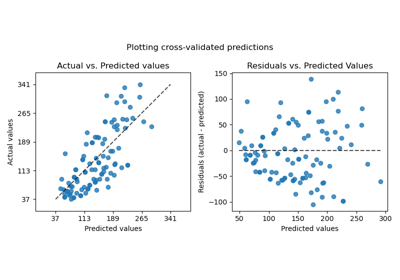-
sklearn.model_selection.cross_val_predict(estimator, X, y=None, groups=None, cv=None, n_jobs=1, verbose=0, fit_params=None, pre_dispatch='2*n_jobs', method='predict')[source] -
Generate cross-validated estimates for each input data point
Read more in the User Guide.
Parameters: estimator : estimator object implementing ?fit? and ?predict?
The object to use to fit the data.
X : array-like
The data to fit. Can be, for example a list, or an array at least 2d.
y : array-like, optional, default: None
The target variable to try to predict in the case of supervised learning.
groups : array-like, with shape (n_samples,), optional
Group labels for the samples used while splitting the dataset into train/test set.
cv : int, cross-validation generator or an iterable, optional
Determines the cross-validation splitting strategy. Possible inputs for cv are:
- None, to use the default 3-fold cross validation,
- integer, to specify the number of folds in a
(Stratified)KFold, - An object to be used as a cross-validation generator.
- An iterable yielding train, test splits.
For integer/None inputs, if the estimator is a classifier and
yis either binary or multiclass,StratifiedKFoldis used. In all other cases,KFoldis used.Refer User Guide for the various cross-validation strategies that can be used here.
n_jobs : integer, optional
The number of CPUs to use to do the computation. -1 means ?all CPUs?.
verbose : integer, optional
The verbosity level.
fit_params : dict, optional
Parameters to pass to the fit method of the estimator.
pre_dispatch : int, or string, optional
Controls the number of jobs that get dispatched during parallel execution. Reducing this number can be useful to avoid an explosion of memory consumption when more jobs get dispatched than CPUs can process. This parameter can be:
- None, in which case all the jobs are immediately created and spawned. Use this for lightweight and fast-running jobs, to avoid delays due to on-demand spawning of the jobs
- An int, giving the exact number of total jobs that are spawned
- A string, giving an expression as a function of n_jobs, as in ?2*n_jobs?
method : string, optional, default: ?predict?
Invokes the passed method name of the passed estimator.
Returns: predictions : ndarray
This is the result of calling
methodExamples
>>> from sklearn import datasets, linear_model >>> from sklearn.model_selection import cross_val_predict >>> diabetes = datasets.load_diabetes() >>> X = diabetes.data[:150] >>> y = diabetes.target[:150] >>> lasso = linear_model.Lasso() >>> y_pred = cross_val_predict(lasso, X, y)
sklearn.model_selection.cross_val_predict()
Examples using
2025-01-10 15:47:30

Please login to continue.